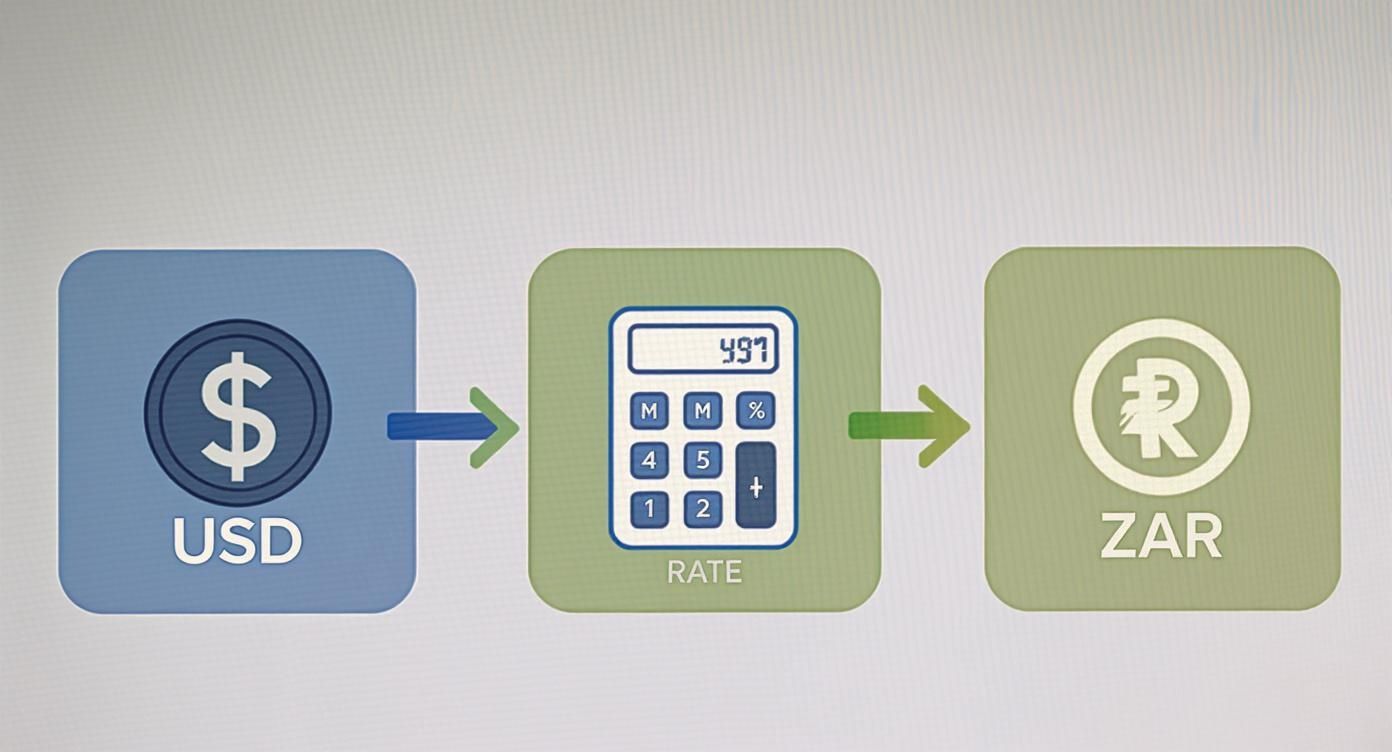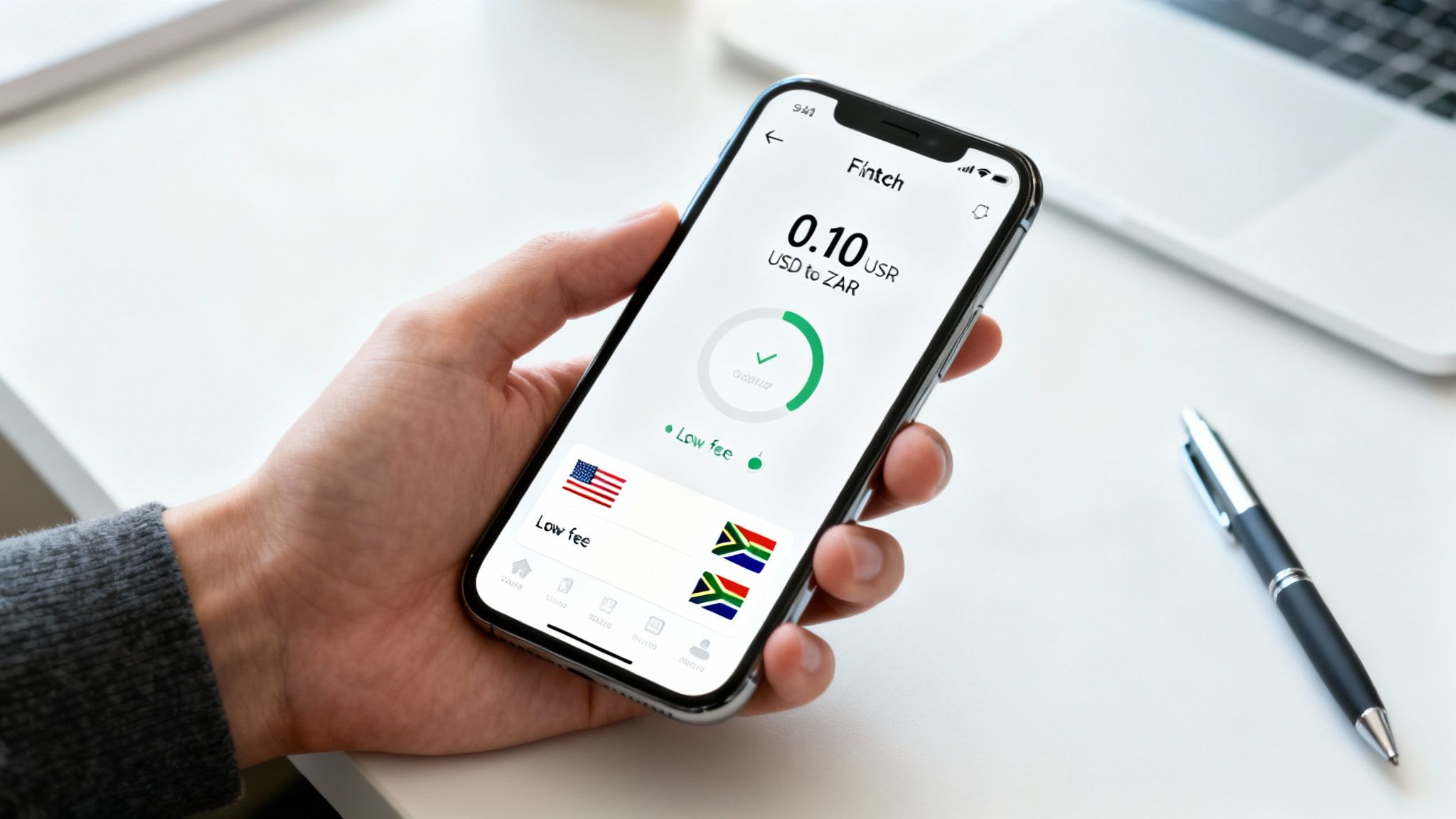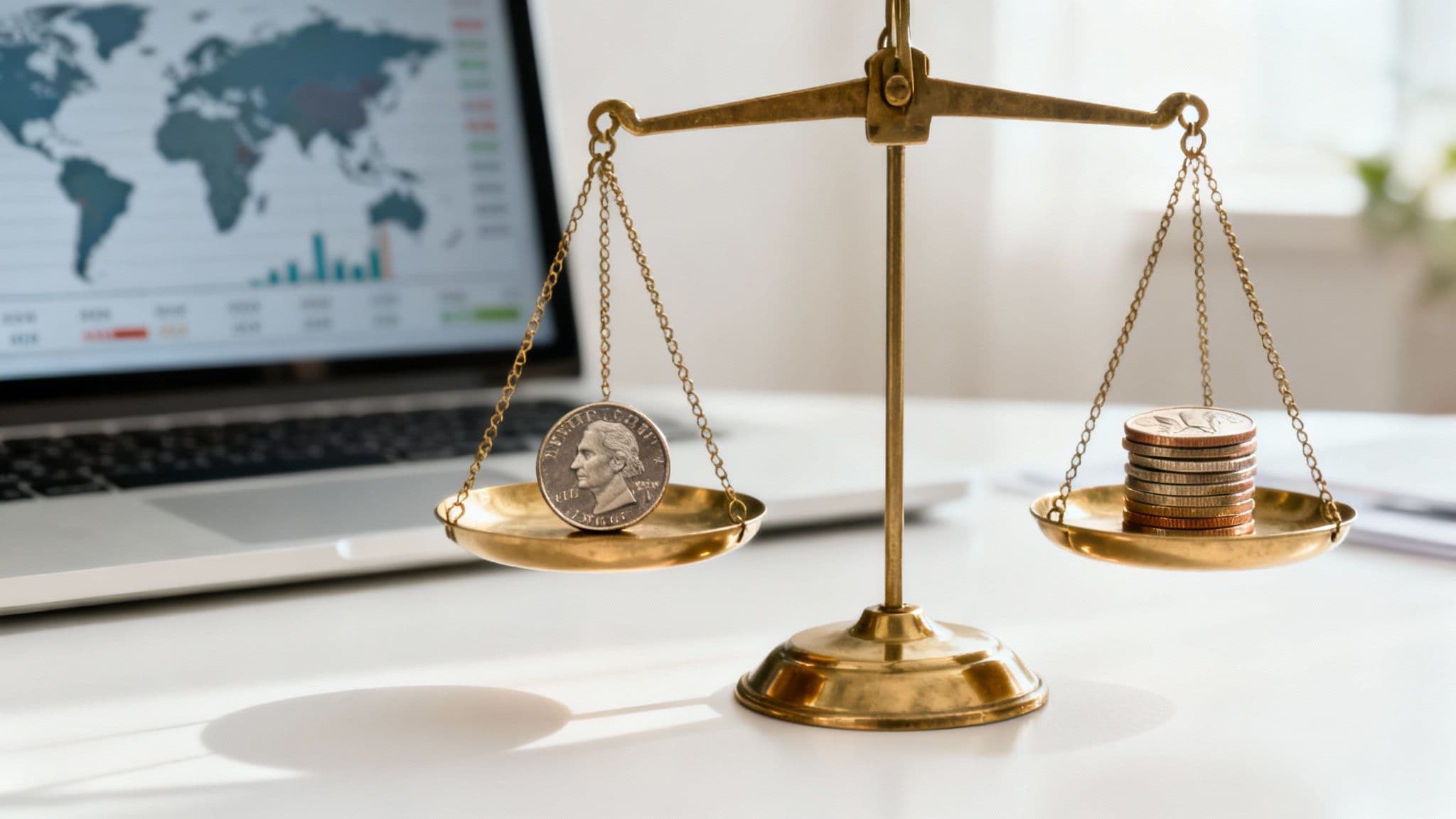Right now, 0.10 USD is worth about R1.72 in South African Rand. That might not sound like much, but if your business pays for digital services, app store fees, or handles countless international micro-payments, these small amounts add up fast. Getting a handle on these conversions is key to managing your costs properly.
Your Quick Guide to Converting 0.10 USD to ZAR
Figuring out the value of US Dollars in South African Rand always starts with the daily exchange rate. This isn't a fixed number; it's constantly on the move, pushed and pulled by the economic health of both the US and South Africa. Even a tiny shift in the rate can make a real difference, especially when you're dealing with a high volume of transactions.
For example, the USD/ZAR exchange rate can change from one day to the next. On a day when the rate is, say, 17.2443 ZAR for every one US Dollar, your 0.10 USD would work out to exactly R1.72443. This is why keeping an eye on currency trends is so important for good financial planning. For deeper insights, you can always check out live data on platforms like TradingEconomics.com.
Example USD to ZAR Quick Conversion Reference
To put things into perspective, here’s a quick reference table. It shows how a few common, small USD amounts convert into ZAR using a sample rate. This helps to visualise how even tiny dollar values become tangible amounts in Rand.
| USD Amount | Approximate ZAR Value |
|---|---|
| $0.10 | R1.73 |
| $0.25 | R4.31 |
| $0.50 | R8.63 |
| $0.99 | R17.08 |
| $1.00 | R17.25 |
A quick heads-up: The values in this table are just examples based on a rate of 1 USD = 17.25 ZAR. Live rates change constantly, so always check the latest mid-market rate for accurate figures before making any financial moves. Remember, the rate your bank or payment provider gives you will be slightly different to cover their costs.
What Really Drives the USD to ZAR Exchange Rate
Ever wondered why the value of 0.10 USD to ZAR seems to change every time you look? It’s not random. Think of the exchange rate like a giant seesaw, with the economic health of the United States on one end and South Africa on the other. A host of powerful economic forces are constantly pushing that seesaw up and down.
At its core, this constant movement is all about supply and demand. If global investors feel good about South Africa’s prospects, they buy more Rands to invest in local businesses and assets. This drives up demand and strengthens our currency. If they get nervous, they sell their Rands, and its value dips.
This infographic breaks down the basic flow of how your dollars are converted into Rands through the exchange rate.

The main thing to remember is that the "rate" is just the dynamic middleman, reacting in real-time to the big economic factors we'll dig into now.
Interest Rates and Inflation
Central banks are the heavy hitters in this game. Both the US Federal Reserve and our own South African Reserve Bank (SARB) set interest rates, which act like magnets for international capital. When the SARB hikes interest rates, it can attract foreign investors looking for better returns on their money. This increases demand for the Rand and, you guessed it, strengthens it.
On the other hand, inflation is like a slow leak in a tyre—it erodes a currency's purchasing power. If South Africa's inflation is running high compared to the US, each Rand buys a little less, making it less attractive. This constant tug-of-war between interest rates and inflation is one of the biggest drivers of the daily exchange rate.
Commodity Prices and Global Risk
South Africa’s economy is deeply connected to its natural resources. As a major exporter of gold, platinum, and coal, the global prices for these commodities directly impact our country's earnings. When those prices are strong, more US Dollars flow into South Africa to pay for our exports, giving the Rand a healthy boost. A slump in commodity prices does the exact opposite.
It's not just about what's happening here at home, though. Global sentiment is a massive factor. During times of worldwide economic uncertainty, investors tend to pull their money out of emerging markets and rush to "safe-haven" currencies, like the US Dollar. This "flight to safety" can weaken the Rand, even if our local economy is doing just fine.
Ultimately, that 0.10 USD to ZAR conversion you see is a reflection of a complex mix of these forces:
- Interest Rate Decisions: Higher local rates can act as a magnet for foreign cash, strengthening the ZAR.
- Inflation Reports: Lower, stable inflation helps the ZAR hold its value over time.
- Commodity Markets: Strong prices for our key exports bring in more foreign currency and support the ZAR.
- Investor Confidence: A positive outlook on South Africa encourages foreign investment, lifting the Rand.
Getting a handle on these forces gives you a much clearer picture of why the rate is always moving and helps you understand the financial world your business operates in.
How Currency Fluctuations Impact Your Bottom Line

Knowing what drives the USD/ZAR rate is useful, but the real test is seeing how those shifts hit your business's bank account. These daily movements aren't just numbers on a screen; they directly translate into real-world costs, revenue, and ultimately, your profit.
For any South African business dealing in dollars, currency volatility is a double-edged sword. Every swing of the pendulum creates a challenge or an opportunity, all depending on which way your money is flowing.
The Importer and Exporter Scenarios
Let's look at this through the lens of two common business types.
If you’re an importer: Buying goods, materials, or even software from the US means a stronger Rand is fantastic news for you. When the Rand firms up, your money stretches further, so it costs you fewer Rands to buy the same amount of US dollars. A $100 software subscription might cost you R1,800 one month but only R1,750 the next, giving your profit margin a direct, welcome boost.
If you’re an exporter: On the flip side, selling to US clients and getting paid in dollars means a weaker Rand is your ally. When you bring that dollar revenue home, a weaker Rand means you pocket more Rands for every dollar earned. An invoice for $1,000 could bring in R17,500 one week, but if the Rand dips, that same invoice could suddenly be worth R18,000 the next.
The constant see-sawing of the exchange rate makes financial planning a real headache. A deal that looks profitable today could turn into a loss tomorrow, making it incredibly difficult to budget accurately without the right strategy.
Managing Financial Volatility
Because these fluctuations have such a direct impact on your cash flow, forecasting becomes an essential survival tool. It helps you anticipate how much ZAR you’ll need and plan for potential shortfalls or unexpected windfalls. To get a better handle on this, it's worth exploring some essential cash flow forecasting methods to build a more robust financial plan.
At the end of the day, watching the 0.10 USD to ZAR rate isn't just for forex traders. For any South African business with overseas dealings, it’s a critical task. Each tiny fluctuation is a direct change to your bottom line, and managing it proactively is key to building a sustainable business.
Calculating Any USD to ZAR Conversion Accurately
Ready to run the numbers yourself? It’s actually pretty simple to figure out any conversion, even something as specific as 0.10 USD to ZAR, once you know the basic formula and where to find the right rate.
At its core, the calculation is just this: USD Amount x Exchange Rate = ZAR Amount.
So, if you need to convert $100 and the going rate is 17.50, you'd just multiply 100 x 17.50, which gives you R1,750. This simple logic works for any amount you can think of, big or small.
Applying the Formula to 0.10 USD
Let's ground this with a real-world example. The performance of South Africa's economy is tightly linked to its exchange rate with major currencies like the US Dollar. For instance, looking at historical data, on October 24, 2025, the South African Reserve Bank posted an official exchange rate of 17.3507 ZAR to the Dollar.
Using that specific rate, our 0.10 USD to ZAR calculation would be 0.10 x 17.3507, which works out to R1.73507. You can dig into these numbers yourself and see how they're reported by visiting the official SARB statistics page.
But here’s the catch—and it's a big one that trips up a lot of businesses. The rate you see published by a central bank or on a quick Google search is almost always the mid-market rate.
The mid-market rate is essentially the "true" exchange rate, sitting at the midpoint between what currency buyers are willing to pay and what sellers are willing to accept. It's the fairest rate you can get, but it's almost never the rate your bank actually offers you.
Instead, traditional banks and most payment providers quietly add their own markup, often called a "spread," on top of that rate. This is their hidden fee, a way to profit from the transaction. It means you end up with a worse rate and lose a slice of your money on every single conversion.
A Smarter Way to Handle International Payments

If you've ever used a traditional bank for international payments, you know the drill. It's often slow, confusing, and surprisingly expensive. Between the fixed transfer fees and exchange rates packed with hidden markups, your profits are quietly being eroded with every transaction.
For any South African business trading globally, these costs are a real drag. What should be a simple payment to a supplier or receiving funds from a US client can become a major operational headache. The old way of doing things just isn't built for the speed and transparency today's market demands.
Thankfully, there's a much better way. Modern financial technology has completely changed the game.
The Fintech Advantage
Fintech platforms were designed from the ground up to fix the exact problems that make old-school banking so frustrating. They operate with far less overhead, which means they can offer you exchange rates that are much closer to the mid-market rate – the "real" rate you see on Google.
This translates directly into more Rands for your Dollars. Whether you're paying an American supplier or getting paid by a client in the States, you get more value from the conversion.
Here’s what that really means for your business:
- Lower Costs: You get to sidestep those hefty transfer fees and inflated exchange rates, keeping more money in your business where it belongs.
- Full Transparency: No more guesswork. You see the actual exchange rate and any small fee upfront before you commit.
- Serious Speed: Forget waiting days for a payment to clear. These transactions are typically processed much, much faster than through the old banking system.
For any business dealing with global markets, getting professional financial guidance is a wise move for managing currency risk and international payments. When you pair a smart financial strategy with the right tools, you've got a powerful recipe for growth.
Got Questions About USD to ZAR? We've Got Answers
Dipping your toes into the world of currency exchange can feel a bit overwhelming, especially when your bottom line is involved. To help you navigate it with a bit more confidence, we've tackled some of the most common questions we hear from South African business owners dealing with USD and ZAR.
When Is the Best Time to Convert USD to ZAR?
Ah, the million-rand question! The honest answer is there's no magic time to convert currency because the market is always on the move. The "best" time really hinges on what you're trying to achieve.
- Bringing USD earnings home to ZAR? You'll want a weaker Rand. A weaker Rand means every dollar you convert stretches a little further, giving you more Rands in your pocket.
- Paying a USD invoice? You're hoping for a stronger Rand. This makes the dollars you need to buy cheaper, costing you fewer Rands to settle your bill.
The smartest strategy isn't about timing the market perfectly. It’s about keeping an eye on economic trends and using a payment partner that gives you consistently good rates and low fees. That way, you can make your move whenever it makes sense for your business, not just when the market forces your hand.
Why Is My Bank's Rate Different from What I See on Google?
That rate you see on Google? That's what's known in the industry as the mid-market rate. Think of it as the 'true' exchange rate—the direct midpoint between what currency buyers are willing to pay and what sellers are asking for. It's the wholesale price, stripped of any markups.
The problem is, this pure rate is rarely what you're offered. Banks and traditional exchange services build their profit into the rate they give you by adding a markup, often called a "spread." This is basically a hidden fee that makes the exchange less favourable for you.
Newer financial platforms, on the other hand, are built to get you as close to that mid-market rate as possible, often cutting out the spread completely.
How Can My Business Handle Exchange Rate Risks?
You can't control the markets, but you absolutely can protect your business from the swings. A popular tool for this is a forward contract. It lets you lock in today’s exchange rate for a transaction that will happen down the road, taking all the guesswork out of future payments or receipts. It's a game-changer for budgeting.
Another great option is a multi-currency account. This allows you to hold funds in USD, so you aren't forced to convert them back and forth with every transaction. You can simply hold onto your dollars and only convert when the time—and rate—is right, saving you a fortune in conversion costs and bad timing.
Ready to stop seeing your profits get chipped away by hidden fees and unpredictable exchange rates? With Zaro, you get the real spot exchange rate with zero spread and zero SWIFT fees. It’s time to take control of your international payments. Learn more and get started with Zaro today.
